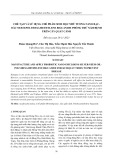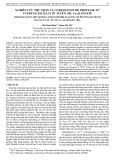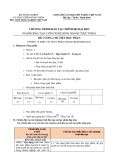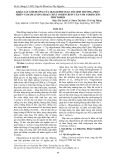
TNU Journal of Science and Technology
229(06): 238 - 246
http://jst.tnu.edu.vn 238 Email: jst@tnu.edu.vn
IN-SITU AND IN REAL TIME OBSERVATION OF PARTICULATE PROCESSES IN
LACTIC FERMENTATION
Le Minh Tam*, Bui Yen Nga, Nguyen Tan Dzung
Ho Chi Minh City University of Technology and Education
ARTICLE INFO
ABSTRACT
Received:
02/4/2024
Controlling bioprocesses requires understanding the behavior of bacterial populations,
which necessitates real-time and in situ appropriate process monitoring techniques.
Current market-available methods require various intermediate steps such as sampling,
dilution, and measurement, which pose potential risks of contamination, in particular
important for fermentation processes. To overcome these disadvantages, in this study,
we develop a novel laser-based measurement that enables the continuously collection
of bacterial population states every second under original conditions, without
additional preparation steps. This innovative method allows collecting up to 25,000 to
30,000 measurement points, effectively capturing the growth, stationary, and decline
phases of lactic bacteria as a case study. The robustness of the technique is evidenced
by the excellent repeatability of duplicated experiments carried out under the same
conditions. Additionally, via this novel method, the lactic fermentation process is
observed that being significantly enhanced in the presence of turmeric and curcumin.
In fact, these compounds reduce the dead rate of lactic bacteria, especially in the case
of curcumin. Particularly, curcumin accelerates the growth and reproduction of L.
Bulgaricus, which is in good agreement with results obtained from our developed
equipment. Adding 2% (w/w) curcumin leads to an approximate 21.4% increase in the
proliferation of the bacterial population. In short, this technique is highly recommended
for monitoring particulate processes in biotech.
Revised:
31/5/2024
Published:
31/5/2024
KEYWORDS
Particulate system
Lactic fermentation
Turbidity
Curcumin
Turmeric
QUAN SÁT TRONG ĐIỀU KIỆN NGUYÊN BẢN VÀ THEO THỜI GIAN THỰC
CÁC QUÁ TRÌNH TRONG LÊN MEN LACTIC
Lê Minh Tâm*, Bùi Yến Nga, Nguyễn Tấn Dũng
Trường Đại học Sư phạm Kỹ thuật Thành phố Hồ Chí Minh
THÔNG TIN BÀI BÁO
TÓM TẮT
Ngày nhận bài:
02/4/2024
Điều khiển quá trình sinh học cần hiểu rõ hành vi của vi khuẩn, điều này yêu cầu cần
áp dụng các kỹ thuật đo trong thời gian thực và điều kiện nguyên bản. Các phương
pháp hiện có trên thị trường cần trải qua các bước trung gian như lấy mẫu, pha loãng,
v.v. gây ra nguy cơ nhiễm khuẩn tiềm ẩn, đặc biệt đối với quá trình lên men. Để vượt
qua các nhược điểm trên, trong nghiên cứu này, chúng tôi phát triển một phương pháp
đo mới sử dụng laser nhằm thu thập thông tin liên tục về trạng thái quần thể vi khuẩn
sau mỗi giây dưới điều kiện gốc mà không cần các bước trung gian. Phương pháp này
cho phép thu thập từ 25.000 đến 30.000 điểm đo, cho thấy hiệu quả trong việc theo dõi
các giai đoạn tăng trưởng, ổn định và suy giảm của vi khuẩn lactic. Độ ổn định của
phương pháp thể hiện thông qua tính lặp lại của các thí nghiệm được thực hiện dưới
cùng điều kiện. Ngoài ra, thông qua cách tiếp cận này, quá trình lên men lactic được
chứng minh rằng có sự tăng cường khi có sự hiện diện của nghệ hoặc curcumin. Trong
thực tế, các hợp chất này giảm tỉ lệ chết của vi khuẩn lactic, đặc biệt là curcumin.
Curcumin giúp tăng cường quá trình sinh trưởng và phát triển của L. Bulgaricus, điều
này phù hợp với kết quả đo được từ thiết bị được phát triển của chúng tôi. Cụ thể, việc
sử dụng 2% curcumin có thể dẫn đến sự gia tăng của quần thể vi sinh vật lên 21,4%.
Như vậy, phương pháp này rất phù hợp để nghiên cứu các quá trình hạt trong công
nghệ sinh học.
Ngày hoàn thiện:
31/5/2024
Ngày đăng:
31/5/2024
TỪ KHÓA
Quá trình hạt
Lên men lactic
Độ đục
Curcumin
Nghệ
DOI: https://doi.org/10.34238/tnu-jst.10020
* Corresponding author. Email: tamlm@hcmute.edu.vn















